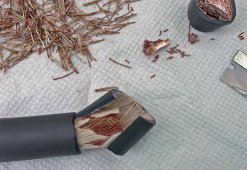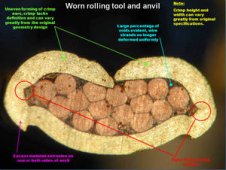Survival_Research
New Member
- Joined
- Nov 19, 2022
- Messages
- 5
Hi, I know this issue has been covered many many times.
I would be interested in reading authoritative studies that recommend NOT performing both a high quality crimp plus high quality soldering for high amperage DC lugs.
Coming from a marine and aerospace environment I am very very familiar with the rationale why soldering is not recommended in those environments which have to do with vibrations weakening the strands over time at the point where the solder ends and the wire goes into the insulation. Generally the other rationale for not soldering refers to the problems with the high heat needed to solder 2/0 or 4/0 lugs creating issues with the insulation on the wire. And the already mentioned other issue being that it creates a brittle area at the end of the solder and the beginning on the wire that leaves the soldered area. Both issues can be addressed with a heavy duty heat shrink that extends a little further down the wire.
I am less convinced however of the reasons why in an application with high DC amperages and no vibration and possibly high humidity and or proximity to coastal (salt water humidity in the air) that a high quality crimp plus the addition of a high quality silver lead tin rosin solder would make for a connection that would be inferior to a crimped connection alone.
From an intuitive reasoning it would seem that whatever voids that would certainly exist between the circular conductors of each strand of wire in even the most highly compressed crimp would still contain some oxygen which, in high humidity environment, can oxidize the copper surfaces in that crimp or wick in moisture which open the possibilities for corrosion and further oxidization to take place over time.
It seems from an intuitive sense that to fill that space with a more cathodic (noble) metal (which is the function of the silver in the lead tin solder alloy - to increase its cathodic property) may address more potential issues that it would create. The reasoning would be that if those gaps were filled with metal it would create a connection with less resistance therefore would be less prone to failure and would also at the same time decrease the amount of oxygen which could enter those spaces between the round strands of the wire in that lug.
The difference may only be that the wire can withstand a few more amps and resist corrosion for a few more years but it seems that from an engineering and reliability standpoint that such increases in current capacity and decreases in possibilities of corrosion may offset concerns over vibration especially in a no vibration environment such as a home solar installation.
I am always looking for the optimal solution so I may be overlooking some issue with solder which would contraindicate its use so I am definitely seeking as much information as possible on this matter. But so far most of the reasons against its use fall under those that I have described above and would not apply in certain applications such as a home system.
I did wiring for Grumman Aerospace for many years and most connections were crimp only but I remain unconvinced that for a high amperage DC lug that a high quality crimp with the addition of a high quality soldering would be a bad idea.
From an intuitive standpoint it would seem that it would be preferable to perform both the crimp and the soldering.
I could be wrong - I am very interested in best practices so any information as to the science of why the dual "crimp + solder" method is less preferable to a crimp alone, would be fascinating and enlightening reading.
Thanks in advance for anyone who has these studies to share.
I would be interested in reading authoritative studies that recommend NOT performing both a high quality crimp plus high quality soldering for high amperage DC lugs.
Coming from a marine and aerospace environment I am very very familiar with the rationale why soldering is not recommended in those environments which have to do with vibrations weakening the strands over time at the point where the solder ends and the wire goes into the insulation. Generally the other rationale for not soldering refers to the problems with the high heat needed to solder 2/0 or 4/0 lugs creating issues with the insulation on the wire. And the already mentioned other issue being that it creates a brittle area at the end of the solder and the beginning on the wire that leaves the soldered area. Both issues can be addressed with a heavy duty heat shrink that extends a little further down the wire.
I am less convinced however of the reasons why in an application with high DC amperages and no vibration and possibly high humidity and or proximity to coastal (salt water humidity in the air) that a high quality crimp plus the addition of a high quality silver lead tin rosin solder would make for a connection that would be inferior to a crimped connection alone.
From an intuitive reasoning it would seem that whatever voids that would certainly exist between the circular conductors of each strand of wire in even the most highly compressed crimp would still contain some oxygen which, in high humidity environment, can oxidize the copper surfaces in that crimp or wick in moisture which open the possibilities for corrosion and further oxidization to take place over time.
It seems from an intuitive sense that to fill that space with a more cathodic (noble) metal (which is the function of the silver in the lead tin solder alloy - to increase its cathodic property) may address more potential issues that it would create. The reasoning would be that if those gaps were filled with metal it would create a connection with less resistance therefore would be less prone to failure and would also at the same time decrease the amount of oxygen which could enter those spaces between the round strands of the wire in that lug.
The difference may only be that the wire can withstand a few more amps and resist corrosion for a few more years but it seems that from an engineering and reliability standpoint that such increases in current capacity and decreases in possibilities of corrosion may offset concerns over vibration especially in a no vibration environment such as a home solar installation.
I am always looking for the optimal solution so I may be overlooking some issue with solder which would contraindicate its use so I am definitely seeking as much information as possible on this matter. But so far most of the reasons against its use fall under those that I have described above and would not apply in certain applications such as a home system.
I did wiring for Grumman Aerospace for many years and most connections were crimp only but I remain unconvinced that for a high amperage DC lug that a high quality crimp with the addition of a high quality soldering would be a bad idea.
From an intuitive standpoint it would seem that it would be preferable to perform both the crimp and the soldering.
I could be wrong - I am very interested in best practices so any information as to the science of why the dual "crimp + solder" method is less preferable to a crimp alone, would be fascinating and enlightening reading.
Thanks in advance for anyone who has these studies to share.
Last edited:






